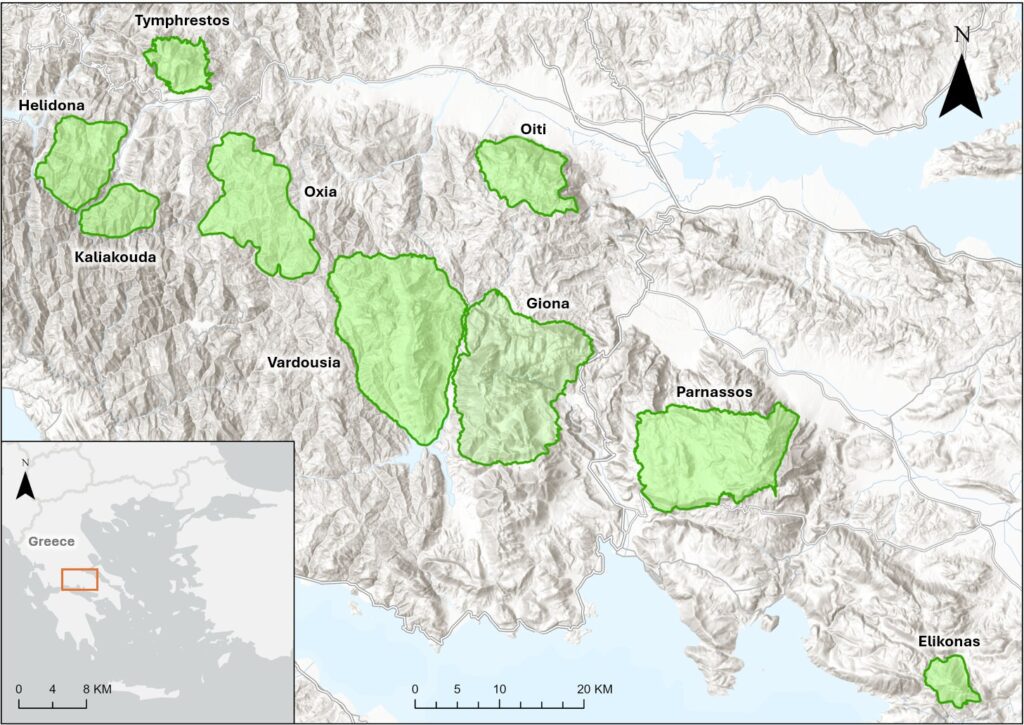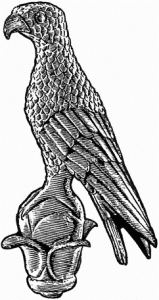PhD: Apostolis Stefanidis
Project info
*The research project was supported by the Hellenic Foundation for Research and Innovation (H.F.R.I.) under the 4th Call for HFRI PhD Fellowships (Fellowship Number: 11266)
Prof. Vassiliki Kati (Supervisor) University of Ioannina
Prof. Sinos Giokas – University of Patras (UOP)
Assoc. Prof. George Fotiadis – Agricultural University of Athens (AUA)
Dr. Olga Tzortzakaki – Postdoctoral researcher (BCL)
Dr. Konstantina Zografou – Postdoctoral researcher (BCL)
Dr. Konstantinos Kougioumoutzis – Postdoctoral researcher (UOP)
Luc Willemse – Orthoptera taxonomist (Naturalis)
Elvira Sakkoudi – Diploma student (BCL)
Ilias Blanis – Diploma student (AUA)
Goal
Research questions
- Explore the diversity patterns of Orthoptera fauna in high mountains
- Investigate the community composition and structure of Orthoptera communities in high mountains
- Estimate the fundamental niche of target species and map their predicted distribution area through ecological niche modeling (ENM)
- Accomplish a thorough update of the conservation status of the four target species under IUCN criteria
- Assess the impact of climate change on the four target species under different climate scenarios through species distribution modeling (SDM)
Actions
1.
Fieldwork
2.
Data analysis
3.
Scientific paper writing
4.
Publications & Dissemination
Concept & Methods
The study area covers a total of 1039 km2 and includes 9 mountain ecosystems, five of which belong to the Natura 2000 network of protected areas.
Ecological models for target species
- ENMs (Ecological Niche Models) will be produced for every target species to cross-validate the species ranges.
- SDMs (Species Distribution Models) will be used to predict the potential distribution of each species under different climate scenarios (for years 2070, 2100) and assess the risks for the populations in the future due to distribution range shrinkage.
- GLMs (Generalised Linear Models) to investigate the microenvironmental parameters that influence the abundance of target species
Community ecology
Explore the composition and structure of Orthoptera communities and the environmental parameters shaping them, in terms of multivariate statistics (ordination, clustering, RDA etc.).
Academic CV - A. Stefanidis
Conferences & workshops
Conferences
- Stefanidis A, Kougioumoutzis K, Zografou K, Fotiadis G, Tzortzakaki O, Willemse L, Kati V 2024. Distribution pattern and conservation ecology of two globally threatened Orthoptera species of Greece. (Presentation). European Congress on Orthoptera Conservation IV. 4-6 July 2024. Rovereto, Italy. https://www.fondazionemcr.it/UploadDocs/26923_booklet_ECOC_IV.pdf
- Stefanidis A, Fotiadis G, Tzortzakaki O, Willemse L, Kati V 2023. (Poster Awarded) Ecology and conservation of two endemic and endangered Orthoptera species of Oiti, Tymphrestos and Vardousia mountains. HELECOS. 11th Hellenic Conference of Ecology. 4-7 October 2023. Patras, Greece. https://www.helecos.gr/en/activities/helecos-congresses/11th-congress
- Tzortzakaki O, Stefanidis A, Kazoglou Y, Faulwetter S, Willemse L, Giokas S 2023. (Poster) Management and conservation of the rare, endemic, and threatened butterfly and Orthoptera species in the National Park of Chelmos Vouraikos. HELECOS. 11th Hellenic Conference of Ecology. 4-7 October 2023. Patras, Greece. https://www.helecos.gr/en/activities/helecos-congresses/11th-congress
- Stefanidis A., Willemse L., Kati V. 2022. Orthoptera diversity patterns on Mitsikeli Mountain. (Presentation) European Congress on Orthoptera Conservation III. 1-2 April 2022. Leiden, Netherlands. https://drive.google.com/file/d/19ZZUWEoMxe91t68XpqGKiW1uF9IISpR_/view
- Noutsou V., Nasiou K., Stefanidis A., Nitas P., Chiotelli K., Tzortzakaki O., Kati V. 2022. (Poster) Saving the last dance: conservation actions for the Epirus grasshopper Chorthippus lacustris. Congress on Orthoptera Conservation III. 1-2 April 2022. Leiden, Netherlands. https://drive.google.com/file/d/19ZZUWEoMxe91t68XpqGKiW1uF9IISpR_/view
- Stefanidis, A., Willemse, L., Kati V. 2021. (Presentation) Orthoptera diversity patterns on Mitsikeli Mountain. HELECOS. 10th Hellenic Conference of Ecology. Ecology and Conservation of Nature: advances and challenges in an age of crisis. 14-17/10/2021. Online Conference. p 92. https://helecos10.gr/wp-content/uploads/2021/12/helecos10-proceedings-final.pdf
Summer schools & workshops
- TEOSS international workshop “Orthoptera Sound System”, 22 – 28 July 2025, Konitsa, Greece. (organization team) https://bc.lab.uoi.gr/en/education-training/teoss/
- TEOSS international workshop “Recording Orthoptera sounds”, 8 – 12 July 2024, Verona, Italy. (participant) https://aeaelbosqueanimado.org/en/teoss-workshop-1-verona-italy/
- Orthoptera Summer school “Orthoptera Taxonomy and Conservation”, 17 – 23 July 2023, Konitsa, Greece. https://cetaf.org/dest/orthoptera-taxonomy-and-conservation/
- Summer school “UNESCO Biosphere Reserves for transboundary ecosystem management and conflict prevention’’ 23 Aug – 1 Sep 2019. Montenegro and Kosovo. https://www.centreforeconics.org/consultancy-and-projects/projects/daad-balkan-2019/
Conferences
|
Summer schools & workshops
|
Papers
Stefanidis, A., Kougioumoutzis, K., Zografou, K., Fotiadis, G., Willemse, L., Tzortzakaki, O., & Kati, V. (2025). Distribution Patterns and Habitat Preferences of Five Globally Threatened and Endemic Montane Orthoptera (Parnassiana and Oropodisma). Ecologies, 6(1), 5.
Stefanidis, A., Kougioumoutzis, K., Zografou, K., Fotiadis, G., Tzortzakaki, O., Willemse, L., Kati, V. 2024. Mitigating the extinction risk of globally threatened and endemic mountainous Orthoptera species: Parnassiana parnassica and Oropodisma parnassica. Insect Conservation and Diversity, 1–15.
Stefanidis, A.; Zografou, K.;Tzortzakaki, O.; Kati, V. OrthopteraCommunity Dynamics andConservation in a Natura 2000 Site(Greece): The Role of Beta Diversity.Diversity2024,16, 11; https://doi.org/10.3390/d16010011
Grants & awards
- Orthopterists’ Society Congress Travel Grant for ICO – Grant to cover the expenses for participation in the 15th International Congress of Orthopterology, Patagonia, Argentina, March 8-12, 2026. https://orthsoc.org/resources/grants-awards/ico-grants-awards/
- PhD scholarship under the 4th Call for Hellenic Foundation for Research and Innovation (H.F.R.I.) PhD Fellowships (Fellowship Number: 11266).
- The Feraki Fund – Grant for Orthoptera research. 2022. Grant to support fieldwork for the project entitled “EOME – Ecology of endemic and endangered Orthoptera species of Μοuntainous Ecosystems in central Greece.” https://www.hzoos.gr/en/announcement/results-feraki-fund-2022
- Theodore J. Cohn Research Fund Grant – The Orthopterists’ Society. 2020. Grant to support fieldwork for the research project entitled “CODE- Conservation of Orthoptera Diversity in central Epirus, Greece.” http://orthsoc.org/
Certifications
Training
- Writing in the Sciences. 1/1/2024. Online course authorized by Stanford University and offered through Coursera. https://www.coursera.org/learn/sciwrite
- Completion of the Global and Regional Assessor for IUCN. 18/09/2021. Online Red List Training: “Assessing Species’ Extinction Risk using IUCN Red List Methodology” https://www.iucnredlist.org/resources/online
- Esri Training – MOOC Cartography (in ArcGIS Pro). 03/2020 – 05/2020. Online Seminars. https://www.esri.com/training/mooc/
Languages
- Greek – Mother tongue
- English – Proficient user C2 (Proficiency of Michigan)
- Russian – Independent user B2 (St. Petersburg State University)
- German – Independent user B1 (Goethe-Institut)
News
News on the PhD project, including notifications of new material published, conference participations, relevant policy impact posted in the BCL facebook page and/or twitter @StefanidisTolis and ResearchGate



